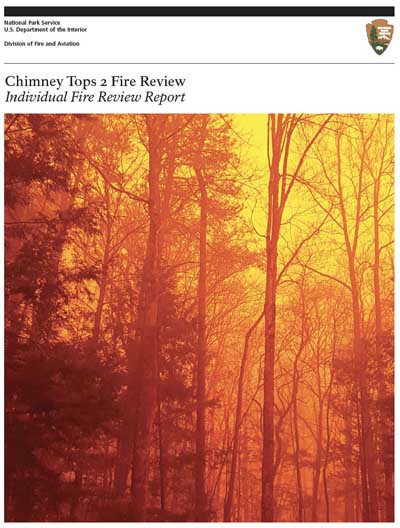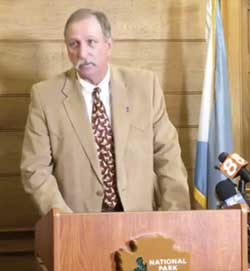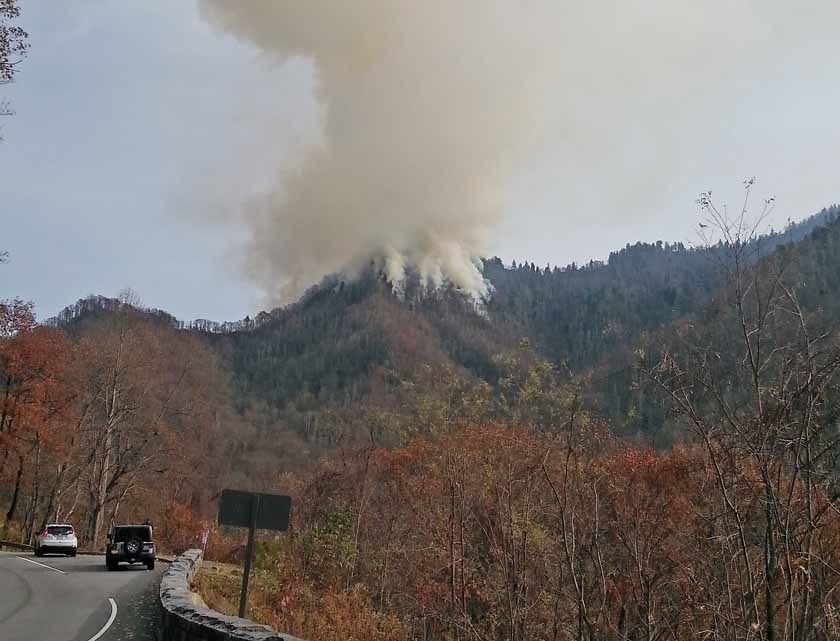 On August 31 the National Park Service released the long anticipated report (12 Mb file) about the wildfire that burned from Great Smoky Mountains National Park into the city of Gatlinburg, Tennessee. Five days after it started on November 23, 2016, the Chimney Tops 2 Fire spread into the eastern Tennessee city killing 14 people, forcing 14,000 to evacuate, destroying or damaging 2,400 structures, and blackening 17,000 acres.
On August 31 the National Park Service released the long anticipated report (12 Mb file) about the wildfire that burned from Great Smoky Mountains National Park into the city of Gatlinburg, Tennessee. Five days after it started on November 23, 2016, the Chimney Tops 2 Fire spread into the eastern Tennessee city killing 14 people, forcing 14,000 to evacuate, destroying or damaging 2,400 structures, and blackening 17,000 acres.
The strategy used to manage the fire was controversial because very little direct action was taken to suppress the fire during those first five days until a predicted wind event caused it to spread very rapidly out of the park and into the city.
The report was presented to the public during a live Facebook feed which you can see below.
One of the first speakers was Secretary of the Interior Ryan Zinke who reminded the audience that he served in combat and then mentioned some recommendations:
- The National Park Service should be more proactive about removing “dead and dying timber”;
- The dozer lines built during the suppression of the fire could be put to good use, possibly as bike paths;
- The interoperability of communications systems needs to be improved so that firefighters from different divisions within the NPS and also between other agencies can more easily communicate during an emergency.
Joe Stutler, qualified as a Type 1 Incident Commander and Area Commander, positions at the pinnacle of the incident management structure, read a lengthy statement that included what he and his team of investigators deemed to be the pertinent facts of the fire and the investigation.

Describing the actions taken or not taken on the fire, he said, “the review team found no evidence of negligence of anyone at the park. They did the very best they could when it came to their duty. They did the very best they could based on what was loaded in their hard drive”, he said as he pointed to his head.

Combined with a wildland/urban interface, it was the “perfect storm”, he explained. The review team concluded that the fire management officials did not see the potential for the low-frequency, high-risk event.
The report made recommendations, including:
- Revise the park’s fire management plan to reflect more aggressive strategies and tactics during extreme fire weather conditions.
- Expand communications capacity to allow interoperability with responders outside the federal system.
- The Fire Management Officer should be supervised by a single individual, not two.
- Since no Red Flag Warnings were issued around the time of the fire, evaluate current Red Flag Warning and advisory criteria to reflect conditions experienced during the 2016 fire season.
- The National Park Service leadership should embrace and institute change to create wildland fire management organizations that have the capacity and resilience to meet the realities of this “new normal” fire behavior.
- Institute formal fire management officer and agency administrator mentoring and/or development programs.

There is no “virgin old growth forest” in the burned area of GSMNP. And while I agree most of the large trees escaped devastation, our homes did not. The fire had nearly burned out of the park boundary when the inferno whipped by the 80MPH winds began. Large mature trees near burned structures were themselves burned and killed. Since GSMNP managed to save all their buildings, you don’t see this devastation in the park.
I was just at the Park and walked the same trail I had before the fire started. I was please to see it was still intact. It has an abundance on virgin old growth that had never been cut down. The forest floor had all burned but the trees did not. I would have to say it was able to shed off the fire because of the shear size of the trees. I believe it to be a healthy forest. Across the street the smaller trees were burned all the way down the mountain. Just a little insight a healthy intact forest will do just fine on its own.
#8, This is exactly what they did by claiming it was a “Perfect Storm”; yet God gave them a brain; they did not use it; and He gave the NPS ample time to prepare and get aggressive before the winds stirred on top of years of knowing that this kind of firestorm could very well unfold.
Exactly.
Federal reporting requirements, code section xx.yy.zz:
1. Blame no one
2. Hold no one accountable
3. Discipline no one
4. Fire 🙂 no one
5. Indicate it is a learning experience
6. Mention everyone did the best job they could humanly do.
7. Mention we have never seen anything like this in the history of the earth.
8. If really bad, blame God.
Number 7 was something my 90 year old mother used to say when she was in the middle stages of Alzheimers.
Good news, my home insurance had just renewed when the fire occurred. Bad news, it will increase over 54% this year. Thanks NPS.
Exactly on point, Doug. I’ve worked for NPS.
White washed report. Again someone or some people are not being held accountable for the poor decision making during the initial attack strategy and tactics utilized by the GSMNP during the Chimney Top 2 wildfire. Sad but not surprised by the report findings. So much for an independent third party investigation and review
The power company was already in my neighborhood repairing downed lines when we drove away from the fire and warned them about its approach. There was no fire in my neighborhood until the Chimney Tops 2 fire, driven by the forecasted high winds, moved in from the park. Where’s your PROOF downed lines caused the fire? I have proof Chimney Tops 2 burned into the city. I videoed the flames in the park, moving across the boundary into the city. No maybe about it. I did read your every word, that’s why I felt it necessary to respond. It took hours for the fire to move north into Chalet Village. The wind arose around 5:00PM. Fires caused by sparking wires caused by wind should have erupted at all sites simultaneously. I’m not excluding sparking wires as a cause of some fires, but the main source of the Nov. 28 fire in Gatlinburg was Chimney Tops 2. It’s not necessary nor helpful to be so condescending. You can have your own opinion, but you by no means have all the facts. Were you in the city, in the fire, that night?
Y’all are being a bit over the top. This was a WUI fire, in nasty terrain, in an area where homeowners, almost to a man, had made no preparation for wildfires, even though the SE was in the middle of a historic fire season. As was stated in the investigations of the two boys that started the initial fire, no one can nail down one fire that caused the fatalities. Remember the wind event? Think of all those powerlines falling, creating a massive complex in a densely populated area, and add in the fact that your fire isn’t really more important than the many other fires-resources were hard to come by. Y’all shouldn’t be so quick to lay blame on the NPS. Hindsight being 20/20, I’m sure it’s easy to pick up mistakes here and there. But do remember that these guys have probably fought a lot more fire than you, Mr. Homeowner.
Gatlinburg’s fire came from the national park. I watched it come over the ridge from the park at 6:00PM and descend into the city. I have video proof. It was not downed power lines. The deaths occurred after that fire spread to other parts of the city/county, later that evening. It’s curious how they were able to save EVERY park structure but unable to keep the fire from reaching Gatlinburg and burning structures there. And in the nine months since their catastrophic failure, what training has been done, what procedures have been changed, what command structure has been revamped at GSMNP or Gatlinburg? Gatlinburg is surrounded by GSMNP. Different NPS wildfire protocols need to be adopted where population centers are so close. Stop blaming the victims. We had no warning. We contacted local fire and police for information and were told they had none. We were told by city workers at 5:30PM we had nothing to worry about. We expected the fire department to respond and fight the fire. Instead they went downtown and left the neighborhoods to burn.
Sigh…you quite obviously didn’t read a word I wrote. You saw a part of the fire coming over the ridge, maybe, but like I said above, it is plain fact that many of the fires spawned from downed powerlines. What, pray tell, would you have had the fire department do? Do you have any understanding of fire, at all? It was 90 mph in a mixed hardwood stand-lot’s of spotting, and quick consumption of the leaf litter. That fire was moving. You live in an area that recieves quite a bit of fire, and yet their wasn’t a single house in Gatlinburg that I saw that had anything close to a defensible space, which frankly is a super basic consideration.
I saw it as well, Connie. I now wish I had videoed it too. I was busy begging Jesus to get my family out as my husband was driving through a wall of fire. At the bottom of Ski Mountain and where the Bypass goes over Ski Mtn Rd, I saw where the flames were entering from the Park boundary.
Well said Carl:
Another horse and pony show by the Dept. of Interior. There were so many aspects of this fire that were not addressed; and suspicious contradictions again. Also, to imply that this was a “perfect storm” is to put the blame on God.
Here again, although we cannot control drought and wind; how the land is managed can undoubtedly help to minimize the impacts of extreme weather and fire. God gave us a brain and expects us to be good stewards of the land. The hands off approach is not working folks. The NPS is the complete opposite of unmanaged timber harvest. Both philosophies do not work. At least the Secretary of Interior addressed the dead timber.
Of course, if prescribed fire is used in some areas to reduce “excessive” fuels, the risk of killing existing trees could happen – despite the controversy with post-fire studies. We may have waited too long.
The potential for this type of fire event was addressed in their fire manuals long ago; and UT Professor Mayer has been warning the NPS for years about the potential for this type of fire. I can go on and on. Leave it to the secular courts; and know that some folks will have to give accountability to the Almighty; for human death was involved in this unfortunate tragic wildfire.
May the fire victims find peace and closure; and may NPS personnel sincerely learn and work to avoid foreseeable events like this. Finally, pray for our fire fighters who are still working amid numerous wildfires.
Tommy
“Never in the history of this park or even in the surrounding area”, Mr. Stutler said, “had anyone seen the combination of severe drought, fire on the landscape, and an extreme wind event” occurring at the same time.”
The drought conditions existed months before the fire started, and the “wind event” was forecast for days. The landscape, fuel load and proximity to the Gatlinburg and Pigeon Forge existed for centuries.
In the western United States, firefighters have dealt with these conditions throughout the fire season virtually every year since the Big Burn in 1910.
Suggesting fire management personnel were somehow victims of anything but the Park’s failed policies and their own ignorance of, or unwillingness to apply, successful management strategies that have been developed over the past century is absurd.
Well stated. Thank you.
Carl, well said but I’d add one more thing. The report mentions having one incident commander. Really? I’ve been in EMS and Fire service for years and having one central incident commander for any Mass Casualty Incident ( MCI) has been SOP in every fire department for over 30 or more years.
well said and totally agree
Tepid dish water is what I expected and this is what they gave to us survivors.
Frustrating isn’t it? And as you’ve said…sadly very predictable.